
©Calibre UK Limited Issue 2.30 15th March 2013, W: www.calibreuk.com
INTRODUCTION
General Introduction
HQView-4xx is a very flexible image scaler developed specifically for driving large screen displays and
multiple screen applications from video or graphics sources.
HQView-4xx features state of the art digital image processor which provides market leading HD & SD
per-pixel multiple Iow-angle motion-adaptive de-interlacing and automatic film pull-down correction for
3:2 and 2:2, significantly outperforming the capabilities of benchmark competitor products. HQView-4xx
features excellent image processing algorithms for the very best scaling, film and video noise reduction
and MPEG artefact reduction.
HQView-4xx uses a very flexible high performance video input front end including true component video
support in analogue YPbPr and RGBS formats and HDSDI/SDI digital formats as well as composite
(CVBS) and YC/S-Video inputs. A very high performance video decoder is utilised with 4x oversampling
and 3D Y/C separation for outstanding video image clarity. HDMI and DVI video with HDCP encryption
is also supported, as are computer graphics inputs in SVGA analogue and HDMI/DVI digital formats.
The output format can be set to I/O Lock mode where it locks the output frame rate to the input frame
rate dynamically without frame rate conversion so as to reduce system latency, or it can be set to a fixed
output frame rate for driving basic screens which are not 50Hz-compatible. A Low latency mode with
non-motion adaptive reduced processing is available to further reduce latency.
Outputs are available in VGA analogue and DVI digital formats which are useable simultaneously so
that one output can drive the screen while the other runs a local monitor.
Note: If an HDCP encrypted signal is connected to the HDMI or DVI input, the DVI output signal will be
HDCP encrypted and the output that cannot be encrypted (VGA analogue output) will be disabled.
Interlaced outputs are supported, there is a vertical temporal filter facility which greatly reduces interlace
flicker.
HQView-4xx supports Pan, Tilt and Zoom to select a ‘region of interest’ portion of the input image, fill
the screen and pan/tilt within it.
HQView-4xx can be operated with different firmware. At time of issuing this document four firmware
versions are available. Each firmware version provides different feature sets controlled through the
menu. Special emphasize is given in the discussion of the OSD (On Screen Display) menu system in
the corresponding chapters.
In the basic configuration HQView-400S used for single display installations Picture in Picture
functionality is provided.
The next version is the HQView-410 for multi screen or multi projector installations such as geometry
correction, Auto Zoom and Edge Blend.
Edge Blend electronically reduces the brightness level of certain image regions to seamlessly match the
brightness of overlapping areas. Auto Zoom automatically crops and zooms the input video image to
display a section of the total image on the corresponding projector or screen. Embedded warp allows
adjustment of the image in a projection scenario to match a rotated, tilted or curved screen. For 9:16
portrait mode signage special predefined portrait modes are available to rotate and stretch a video
image to fill a +/-90° rotated display panel.
HQView-420 adds free form warp capability for non-flat screens in single or multi projector installation.
Warp maps created with the PC tool “Warp Generator” can be uploaded into HQView-420 and
processed accordingly.
System control is via an OSD controlled by keys on the front panel or through the inbuilt TCP/IP web
server.
Additionally a free API manual is published on our website at the link given below to allow the use of the
LAN or RS232 remote control ports.
http://www.calibreuk.com/documents/hqview/HQView_LEDView%20API%20Protocol_v2.02%20Generic
.pdf




































